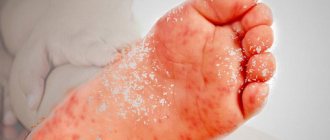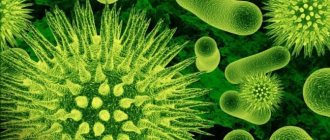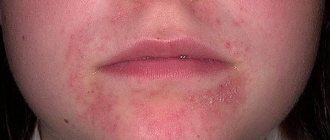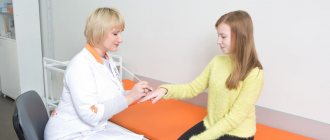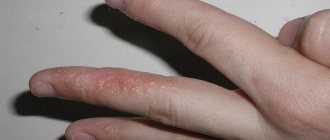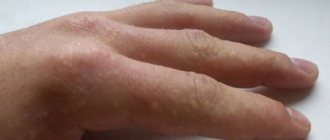A rash on the palms usually appears as itchy, painful spots that are red in color, blisters, or small blisters that are filled with pus. This rash is usually localized inside the palms. It can also appear between the fingers. Allergies, contact dermatitis - there really are plenty of reasons. If this is an allergy, then the trigger, that is, the irritant, can be cosmetics, household chemicals, pet hair, and so on.
But the rash may also be the result of some infectious disease. You can remember chickenpox, rubella, syphilis and so on. There may also be autoimmune disorders, such as psoriasis or rheumatoid arthritis. Finally, we must not forget about stress factors, heat and frost exposure, and the influence of medications.
Make an appointment with a dermatologist by phone or by filling out the online form
| Select a clinic | Demodicosis | Rash on shoulders | Dermatologist at home |
Types of rash
The location of the rash can be a direct indication of the type of disease. If it's your hands, most likely it concerns allergic diseases. Another important factor is the size of the rash, because the spots can be large or, conversely, small.
The types of rash on the palms can be varied:
- Spots – contribute to the change of skin pigment and are located at the skin level. May vary in colors.
- Pustule – there is pus inside the elements.
- Erosion - there is filling inside and the elements differ in color.
- Bubbles – there is a watery content inside and there are different sizes.
- Blisters.
- Dry crusts.
If the resulting rash begins to itch, we are talking about infectious diseases. For example, a person gets chickenpox. In humans, such a disease is quite complex and can have serious consequences. Allergic reactions require relief from the allergen.
At times, the rash can be caused by a state of severe stress, as mentioned above, or as a result of prolonged overwork. As a result, human immunity becomes weaker. Therefore, doctors advise spending more time outside and breathing fresh air there. When the first signs appear, you should contact a dermatologist. The skin is represented by a certain indicator that notifies that serious health problems may begin.
Common symptoms and manipulations in dermatology:
- Skin rashes
- Calling a dermatologist to your home
- Itching in the urethra
- Itchy skin
- Skin rash
- Prevention of casual sex
- Skin neoplasms
- Pyoderma
- Pityriasis rosea
- Streptoderma
- Scabies
- Peeling skin
- Fungal infections
- Skin infection
- Pus on the skin
- Blisters on the skin
- Papillomas on the foreskin
- Sexually transmitted diseases
- Skin structure
Rash
We all get sick. Often or rarely, mildly or severely, we get sick. It’s a banal truth, but that’s just the way people are made - either something breaks inside, or someone attacks outside. Those who pounce can often be identified by sight - dogs, for example, or young people bored in a dark alley. The latter often leave marks on our body in the form of bruises and bites, which, of course, darkens our existence, since it spoils our beauty and interferes with fruitful communication with people of the opposite sex. However, it also happens: it seems like no one touched you, but you look in the mirror and your hair stands on end - you’re all kind of spotty or bubbles are jumping up here and there. Nightmare! The feeling described above is familiar to almost every adult, especially when you consider that when such spots or blisters appear not on himself, but on a child, then this is no less a nightmare. Doctors call various changes on the skin that suddenly appear as a rash . There are several dozen diseases in which a rash always occurs, and several hundred in which it can occur. The vast majority of these diseases are not terrible at all, but there are also very (!) dangerous ones, so you need to be careful with the rash . To begin with, we note that there are three groups of diseases in which rashes may appear on the skin:
- Infectious diseases.
- Allergic diseases.
- Diseases of the blood and blood vessels.
Let's take a closer look at them. Infectious diseases are the most common cause of rash , and making sure that the cause of the rash is an infection is usually not difficult. After all, in addition to the rash , there must be other signs of an infectious disease - contact with an infectious patient, acute onset, increased body temperature, loss of appetite, chills, something hurts (throat, head, stomach), or something is swollen, or runny nose, or cough, or diarrhea, or... A rash in diseases that are caused by viruses - measles, rubella, chickenpox - these are the most common, but there are many others with scary names - herpes infection, infectious mononucleosis, erythema infectiosum, etc. A feature of all these diseases is the almost complete lack of opportunities to fundamentally help the patient, since effective ways to combat viruses have not yet been invented. But there is nothing particularly sad about this - the human body copes with the virus on its own within one to two weeks. True, under one condition - that it is a child’s body. Measles, rubella, and chickenpox in adults are quite severe and are often accompanied by complications. This, by the way, leads to a very useful conclusion about the benefits of visiting preschool institutions in order to get sick on time than you should. Infectious rashes can be caused by bacteria. With them, on the one hand, it is simpler - there are antibacterial drugs (antibiotics, sulfonamides) that can help the sick person. But, on the other hand, the diseases themselves can be very serious, when the rash is so small compared to everything else. The most common bacterial infection with a rash is scarlet fever, but everyone knows about many other diseases that cause a rash - typhoid and typhus, syphilis, meningitis, staphylococcal infection (the list, unfortunately, is far from complete). A rash as a manifestation of an allergy is not at all uncommon (to put it mildly). Thoughts about the allergic nature of the disease in general and the rash in particular arise, as a rule, when, firstly, there are no signs of infection - that is, the general condition is not particularly disturbed, the temperature is normal, appetite has not disappeared and, secondly, there is something to sin about - that is, there was contact with something (someone) that could be the source of the allergy. This something could be eaten (citrus fruits, chocolate, pills), this something could be injected (medicine), this could be breathed in (painted, sprayed, anointed), this something could be rubbed against (cats, dogs, rugs, clothes that are “well” dyed or washed in something “good”. From the above, it is easy to conclude that there are four main types of allergies - food, drug, respiratory (respiratory) and contact. The possible cause is not always obvious, and the search for it often turns the doctor, the patient and his relatives into true followers of Sherlock Holmes. The rash associated with the blood and vascular diseases we mentioned occurs for two main reasons.
- A decrease in the number or disruption of the functioning of special blood cells - platelets, which are actively involved in the blood clotting process (often congenital).
- Violation of vascular permeability. The rash in these diseases takes the form of large or small hemorrhages, its appearance is provoked by injuries or other diseases - for example, an increase in temperature during a common cold.
From the above it is easy to conclude: it is not always possible to clearly identify the cause of the rash . For example, a person fell ill with pneumonia. a rash appeared . That is, the cause of the disease is an infection, and the cause of the rash is an allergy. Well, now the results, conclusions and some other useful information.
- The most terrible rash occurs with the so-called meningococcal infection . Meningococcus is a microbe that most often causes meningitis, but in addition to meningitis, it can cause blood poisoning, a condition doctors call meningococcemia. , less than a day may pass from the appearance of the rash It is in this regard that I really, really ask you: be sure to show any rash to a doctor, and the sooner the better. If the appearance of a rash is accompanied by vomiting and high fever, and elements of the rash look like hemorrhages, use all (!) opportunities to deliver the sick person to the infectious diseases (or at least to the nearest) hospital as quickly as possible.
- Of the three main childhood viral infections with rash (measles, rubella, chickenpox), measles is the most dangerous, but in vaccinated children it is either not observed or is mild. Don't ignore preventive vaccinations!
- Anyone with a rash should be kept away from pregnant women until the doctor says it is not rubella (the rubella virus is very dangerous for the fetus).
- If the rash is very, very itchy (especially at night), then you may well have scabies . This is not a virus or a bacterium, it is a mite that crawls in the skin, occasionally coming to the surface and leaving elements of a steamy rash (entrance and exit). Scabies is not at all a shameful disease for a specific person, but it is shameful for society as a whole. You can pick it up on a crowded tram, on the railway, and... But you never know where and what you can pick up now? You just can't run it. Therefore, if you can’t sleep because of itching, go see a dermatologist in the morning, maybe you’ll feel better.
- Remember that the cause of a rash is usually internal, not external. No amount of blue, brilliant green, iodine or potassium permanganate can help the patient. But if you really want to smear yourself or paint your baby, please, just show the rash to the doctor first, and only then paint.
Good luck, and may the rashes pass you by!
author Komarovsky E.O. published 17/01/2007 17:58 updated 12/03/2016 - Diseases and treatment
Causes of rash on palms
If a rash occurs on the palms, most often it is a sign of an infectious disease, one of its symptoms. It is extremely rare when a rash is not associated with infections, but is only a reaction to external irritants.
A rash on the palms usually appears for reasons such as:
- infectious inflammation of the skin;
- development of infection inside the body;
- helminthic infection;
- vascular pathologies;
- an allergic reaction to something.
A rash on the palms may be a sign of the development of diseases such as syphilis, measles, mumps, rubella, and so on. You should take the occurrence of such a symptom very seriously and be sure to visit a doctor, or call a doctor at home.
According to statistics, more than 74% of skin diseases occur due to parasitic infections of the body. These are roundworms, lamblia, toxocara, and so on. A helminthic infestation always causes enormous damage to the body.
It is worth carefully analyzing the possible causes in order to inform the doctor about this. Perhaps the rash appeared after communicating with a sick person, after contact with animals, after eating new drinks or foods. Pregnancy is also a trigger for unexpected rashes.
If measures are not taken in time and not diagnosed, then the pathology will develop, which means the treatment will take longer.
What is atopic dermatitis
Atopy is a special type of allergic hypersensitivity of the body, which is associated with the development of asthma, hay fever and chronic dermatitis (skin inflammation).
Atopic dermatitis occurs most often in children, including infants, although the disease can develop at any age. The pathology is characterized by a chronic course with periodic exacerbations. With age, the disease usually goes into a stage of long-term remission.
The disease affects 10–20% of the population, and 90% of patients are children under 5 years of age. Among infants under one year of age, the prevalence of the disease is about 10%.
What tests need to be taken for a rash on the palms
To accurately understand the causes of skin rashes on the palms, the doctor will order tests.
The list of standard examinations includes:
- analysis of the contents of pustules, skin scrapings;
- general blood analysis;
- blood chemistry;
- blood for allergens;
- blood for helminth detection;
- feces on worm eggs.
If sexually transmitted infections are suspected, a blood test will be ordered for syphilis, gonorrhea, and so on.
You can get tested without leaving your home. Our clinic offers this service at home and transportation of biomaterial to the laboratory. Test results can be obtained on the same day of treatment.
What diseases cause a rash on the palms
A rash on the palms is just one sign of many diseases. This condition occurs in infectious and non-infectious pathologies. In addition to the rash, high fever, abdominal pain, loss of appetite, nausea, vomiting, and deterioration of health may occur. You must immediately seek medical help, since wasting time can threaten the health and sometimes the life of the patient.
Among the possible diseases that occur with rashes on the palms are:
- meningitis;
- piggy;
- rubella;
- syphilis;
- measles;
- scarlet fever;
- dyshidrosis;
- advanced stage of fungal skin infection;
- chicken pox and much more.
It is impossible to establish an accurate diagnosis based on just one sign. The doctor will prescribe a series of tests to determine the type of pathogen. Based on the data obtained, a treatment regimen will be drawn up.
One of the most dangerous diseases accompanied by a rash is meningitis. This is a viral disease, but there is also a bacterial form. She's more insidious. One of the signs of this type of meningitis is a rash localized on the legs, arms, and sides of the body. This rash is bright red, sometimes with a purple tint, and does not rise above the skin. When pressed, the color of the rash does not fade. In addition to the rash, the pathology causes severe headache, muscle spasms, vomiting, and high fever. Emergency assistance required.
Dyshidrosis mainly affects people who are prone to allergies or have a hereditary predisposition. The disease occurs due to decreased immunity, central nervous system disorders, and disruptions in the endocrine system. Rashes on the palms appear periodically, since the disease has a chronic form. The rash is small, subcutaneous, and can merge with each other. There is liquid inside, and after the bubbles burst, erosions and crusts remain. The rash is accompanied by itching.
A dangerous condition that causes a rash on the palms can be anaphylactic shock or allergic purpura.
Stages and symptoms of the disease. Diagnosis of atopic dermatitis
The stages of atopic dermatitis usually depend on the age of the patient.
- In infants at 2–3 months, a rash first appears on the cheeks and chin, which turns red, enlarges and begins to become weeping. As soon as the child begins to crawl, such blisters appear on exposed areas of the elbows and knees. The child is restless due to itching and constant skin irritation. By 1.5 years, the disease activity gradually subsides.
- In older children, the rash appears behind the knees, on the inside of the elbows, on the neck, wrists, ankles, and hands. It is represented by compactions, which are then covered with scales from constant scratching. The skin around the lips becomes inflamed and painful cracks appear on it. In severe cases of the disease, the child's growth slows down. After puberty, the manifestations of the disease disappear in almost all patients.
- Some adults have been ill since childhood; the first manifestation of the disease in adulthood is less typical. Symptoms of the pathology are typical, most often the limbs are affected, and a rash around the nipples occurs. There is dryness, cracks and itching of the skin on the arms and legs. Sleep and performance suffer. One of the common concomitant diseases in this case is early cataracts, so patients with atopic dermatitis need to be regularly examined by an ophthalmologist.
Symptoms of atopic dermatitis:
- the main symptom is itching of the skin, accompanied by scratching and secondary infection;
- during the period of remission, dry skin and cracking are noted;
- During the period of exacerbation, weeping crusts form in the affected areas, the skin turns red and swells.
Diagnosis of atopic dermatitis should be carried out by an experienced dermatologist. It is based on an assessment of the external skin reaction and the patient’s complaints. A special scale of disorders has been developed, with the help of which the diagnosis is confirmed.
Additionally, the blood is examined to determine the number of eosinophils (allergic cells) and specific immunoglobulins E (antibodies to specific allergens).
Skin biopsy and skin allergy tests are not used in the diagnosis of atopic dermatitis.
Rash on the palms of a child
Attentive parents should take the appearance of rashes on their child’s palms very seriously. This may be evidence of very dangerous diseases.
It is worth paying attention to other symptoms:
- increased body temperature;
- dry cough;
- feeling of nausea and loss of appetite;
- pain in the stomach or throat;
- the appearance of nasal discharge;
- general lethargy.
We must also consider other areas of the body. Perhaps the rash appeared on the feet, stomach, sides of the body, or in the mouth. You should remember what new food the child ate or with whom he came in contact. All these points are very important when collecting anamnesis and will help the doctor make a preliminary diagnosis.
Rashes on the palms of a child can be caused by infectious diseases of a cold nature or a viral infection.
Diseases accompanied by a rash in children are more often:
- measles (rashes begin from the head, then move to the torso, palms, arms, legs);
- chickenpox (spots turn into blisters, the rash itches, appears not only on the palms, but also on the head, mouth, and torso);
- rubella (small rashes on the folds of the arms and legs, on the outside of the palms, as well as general intoxication of the body);
- scarlet fever (at first it occurs like a sore throat, a sore throat, and the second time a rash appears in the form of small dots on the folds of the skin, in the folds, between the fingers);
- urticaria (an allergic reaction to animal hair, flowers, dairy products, sweets, powder, cream, while the rash is bright red and itchy);
- mosquito, flea, bee and wasp bites, to which the baby has an allergic reaction (proceeds like allergic rashes, itches);
- scabies (the rash is very itchy, affects the arms and hands, mite tracts are visible);
- disease of the circulatory system (small rash in the form of dots due to rupture of small vessels).
A rash on the arms and legs may occur due to contact with nettles. And also due to poor hygiene. Infants often have the so-called prickly heat. The rash appears in places where it is constantly damp.
| Appointment with a dermatologist at the clinic. Call a dermatologist at home. | Reception is strictly by appointment, make an appointment by phone: +7 | Prices for services | Reviews about the clinic |
Causes and forms of atopic dermatitis in children and adults
The causes of atopic dermatitis are not precisely known. The disease occurs in people genetically predisposed to it, who have additional immune disorders, under the influence of unfavorable factors. This pathology is not contagious.
Allergic atopic dermatitis can develop under the influence of the following trigger factors:
- contact: allergens (animal hair) or irritants (soap, detergent, perfume, gasoline and other organic substances);
- inhalation: dust, pollen, mold, particles of human and animal dander;
- infectious: Staphylococcus aureus, candidiasis pathogens;
- food: eggs, milk, legumes, citrus fruits, fish, peanuts, cereals (a reaction to them is an indicator of severe dermatitis).
Clinical forms of atopic dermatitis:
- exudative: reminiscent of eczema, characterized by acute inflammation, swelling, weeping and itching;
- erythematous-squamous: thickened skin turns red, acquires a darker shade, and multiple scales form on its surface;
- lichenoid: thickened skin with constant scratching and scratching, often accompanied by a secondary bacterial infection.
In adults, the lesion is most often located on the flexor surfaces of the elbows, under the knees; in young children, the rash appears on the face and extensor surfaces of the joint.
Rash on the palms of pregnant women
During pregnancy, hormonal levels are disrupted. This may affect the condition of the skin such as allergic dermatitis. Habitual creams, soaps or foods can cause an allergic reaction.
Upon repeated contact with the allergen, the rash and swelling occur again. Usually everything goes away on its own if the irritant is eliminated. But it often happens that a woman does not immediately realize what causes such a reaction. And he continues to use the same household chemicals or cosmetics that cause a reaction. In this case, the allergy intensifies.
The danger with such rashes is that if a rash with blisters occurs, they burst and a bacterial infection can occur. And women’s immunity is weaker during this period. Therefore, it is better to consult a doctor immediately.
The danger is also that the rash may be a sign of rubella. And this is a dangerous disease for pregnant women, causing damage to the fetus.
Rashes can also be a consequence of conditions such as:
- herpes (herpes in pregnant women has nothing in common with classic herpes, it is an autoimmune process, that is, the body’s allergic response to its own tissues, the rash occurs in the form of spots, blisters, papules);
- erythema or telangiectasia (if the amount of female sex hormones estrogens in the blood is increased).
Any strange changes in the body of a pregnant woman and manifestations in the form of a rash should be a reason to consult a doctor.
Why does a rash appear in blisters on the palms and soles of a child?
The most common cause of a rash on the palms and feet is nothing more than an allergic reaction. It usually appears in children in infancy, up to three years. Therefore, it is recommended to wash all items with hypoallergenic powder and not use fragrances.
Why does a rash appear with blisters on the palms and soles of a child:
- A child may have food allergies, even if the mother is breastfeeding. This is due to the fact that some of the dyes, as well as nutrients from food products, enter breast milk, thereby causing food allergies.
- Please note that if you have recently given your child medications or undergone treatment, you may be allergic to some antibiotics, vitamins, and antiviral drugs.
- An allergy can occur to any medicine, regardless of the child’s age and the treatment for a particular illness. Therefore, if a rash appears a few days after taking medication, you should suspect a drug allergy.
Fever and rash in a child
Is the rash on the palms contagious?
If the rash is caused by infectious diseases, fungi or parasites, then more often it is a contagious course of the disease.
These include:
- rubella;
- measles;
- meningitis;
- scabies;
- scarlet fever;
- chicken pox and so on.
Diseases are transmitted by airborne droplets, contact or household contact. With such diseases, the patient must be isolated from others until complete recovery. With helminthic infestations, it is also possible to infect other people in contact with a sick person if basic hygiene rules are not followed, for example, washing hands after using the toilet.
If the rash occurs due to an allergic reaction, then there is no threat of infection. Allergies are the individual characteristics of everyone’s body.
The cause of the rash should be determined as quickly as possible to ensure that it is not spread to others. Timely treatment will avoid serious consequences of the disease.
Answers to frequently asked questions about skin rashes:
- Which doctor should you contact for a skin rash?
- Is the skin rash contagious?
- What diet is necessary for skin rashes?
- What diagnosis is needed for a skin rash?
- Why is a skin rash dangerous?
- Why is it necessary to get tested for a skin rash?
- What diseases does a skin rash indicate?
- What examination is necessary for a skin rash?
- Which skin rash is dangerous?
- How to distinguish an allergic rash from an infectious one
- How to get rid of skin rashes?
- How to get rid of itching skin rash?
- What organs are affected by a skin rash?
- How to prepare for an appointment with a dermatologist?
- How to get checked for skin diseases?
- What diseases does a dermatologist treat?
- What tests should be taken by a dermatologist?
- What diagnostics can a dermatologist perform in the clinic?
- Where to go with a skin disease?
Treatment at the Mama Papa Ya clinic
The Mama Papa Ya clinic chain offers medical services to patients with atopic dermatitis at an affordable price. Our advantages:
- treatment of all family members suffering from this disease;
- recommendations for the prevention of dermatitis in children predisposed to it;
- simultaneous complex treatment by a gastroenterologist, neurologist, dermatologist, ophthalmologist and other specialists;
- prescribing the most modern means for the treatment of dermatitis;
- recommendations for nutrition and skin care;
- various physical procedures to prevent exacerbations;
- recommendations for pregnant women on the prevention of disease in newborns.
You can make an appointment by calling. The clinic's branches are located in Moscow and the Moscow region.
Reviews
Good clinic, good doctor!
Raisa Vasilievna can clearly and clearly explain what the problem is. If something is wrong, she speaks about everything directly, not in a veiled way, as other doctors sometimes do. I don’t regret that I ended up with her. Anna
I would like to express my gratitude to the staff of the clinic: Mom, Dad, and me. The clinic has a very friendly atmosphere, a very friendly and cheerful team and highly qualified specialists. Thank you very much! I wish your clinic prosperity.
Anonymous user
Today I had a mole removed on my face from dermatologist I.A. Kodareva. The doctor is very neat! Correct! Thanks a lot! Administrator Yulia Borshchevskaya is friendly and accurately fulfills her duties.
Belova E.M.
Today I was treated at the clinic, I was satisfied with the staff, as well as the gynecologist. Everyone treats patients with respect and attention. Many thanks to them and continued prosperity.
Anonymous user
The Mama Papa Ya clinic in Lyubertsy is very good. The team is friendly and responsive. I recommend this clinic to all my friends. Thanks to all doctors and administrators. I wish the clinic prosperity and many adequate clients.
Iratyev V.V.
We visited the “Mama Papa Ya” Clinic with our child. A consultation with a pediatric cardiologist was needed. I liked the clinic. Good service, doctors. There was no queue, everything was the same price.
Evgeniya
I liked the first visit. They examined me carefully, prescribed additional examinations, and gave me good recommendations. I will continue treatment further; I liked the conditions at the clinic.
Christina
The doctor carefully examined my husband, prescribed an ECG and made a preliminary diagnosis. She gave recommendations on our situation and ordered additional examination. No comments so far. Financial agreements have been met.
Marina Petrovna
I really liked the clinic. Helpful staff. I had an appointment with gynecologist E.A. Mikhailova. I was satisfied, there are more such doctors. Thank you!!!
Olga
Which doctor treats rash on palms
A rash on the palms is usually treated by a dermatologist. A dermatologist is a specialized specialist whose responsibility is to determine the causes and treat diseases of the skin and mucous membranes.
Our clinic employs a highly qualified dermatologist with extensive experience. It is certified to accept adults and children.
If necessary, the dermatologist will refer the patient for a consultation with an immunologist, allergist, or infectious disease specialist.
Treatment of the disease
Diet for atopic dermatitis:
- limiting or eliminating food allergens;
- refusal of carbonated drinks and confectionery products;
- refusal of spicy, salty, smoked, fried foods, marinades, mayonnaise;
- Fermented milk products, vegetables, and fruits common in the diet are useful.
Folk remedies for atopic dermatitis are used after consultation with a doctor:
- Using only one type of soap and detergent without fragrance;
- applying moisturizers, for example, boiled sunflower oil, to damp skin without wiping it with a towel;
- avoiding hot baths;
- It is useful to add bran decoction, infusion of string and chamomile to warm bath water, as well as a little potassium permanganate to disinfect the skin,
- Compresses made from grated raw potatoes and black tea lotions will help relieve itching.
How to cure atopic dermatitis with medications:
- drug therapy is necessary when conventional skin care products are ineffective;
- ointments and creams with glucocorticoids are most often prescribed;
- effective treatments for atopic dermatitis are ointments based on tacrolimus and pimecrolimus, which can be used even in children.
If necessary, treatment of atopic dermatitis is supplemented with antihistamines, antibiotics, enterosorbents, and sedatives. Phototherapy is prescribed. In severe cases, short courses of glucocorticoids and immunosuppressants are used to relieve exacerbations.
Where to go with a rash on the palms
A rash on the palms can be a sign of many diseases. You cannot diagnose yourself; you must seek qualified medical help at a medical institution.
Advantages of seeking help from our clinic:
- We work any day, without holidays and weekends;
- The appointment is conducted by an experienced dermatologist;
- The clinic’s staff also includes allergists, immunologists and infectious disease specialists, whose consultation may be required;
- The clinic’s own laboratory allows you to quickly and easily take all the necessary tests and get results on the day of treatment;
- There is a service to call a doctor at home, which is much more comfortable for the patient.
Our clinic provides assistance to both adults and children. The well-equipped clinic, professional medical workers, polite and friendly attitude contribute to a speedy recovery.
Treatment of rash on palms
There is no general treatment regimen for rashes on the palms. It all depends on the diagnosis and the characteristics of the patient’s body. Treatment must be prescribed by a doctor. Before coming to the doctor, you should not use products that change the appearance and color of the rash - iodine, brilliant green, fucorcin.
Treatment is prescribed only after all tests have been completed. It includes:
- In simple cases, certain ointments and creams that are used to treat the affected areas of the body are sufficient. Sometimes tablet medications and injections are added to the treatment regimen. These can be hormonal, antiviral, antibacterial, antifungal, antihistamine drugs.
- Prescription of physical procedures. This includes ultraviolet treatment and other types of exposure.
- Children are prescribed baths with medicinal herbs that relieve itching and inflammation.
- For bacterial skin lesions, antibiotics are added to the treatment regimen in a certain dose.
- Vascular diseases require special treatment, using specific drugs.
- Sulfur and other ointments help with scabies. But the choice of remedy is determined by the doctor.
Folk remedies can complement treatment. Their feasibility is agreed with the doctor.
Urticaria in children
At the threshold I was met by a thin, intelligent-looking man. “The child’s mother will be there now, running,” he told me. And a minute later the doorbell actually rang. “Here comes my wife!” - Dad exclaimed joyfully.
“I haven’t seen my girl for a long time!” - exclaimed the happy husband. The next moment he was tenderly hugging his swollen 150-kilogram wife. Or rather, he hugged only half of his beloved, as far as his not too long arms could reach. My beloved’s T-shirt was wet in the armpits. She smelled terrible of sweat. “I just got back from training - I was lifting weights,” she simply told me. “Maybe she hasn’t recovered from her pregnancy yet?” — I involuntarily thought, although this was not relevant.
The mother of my little patient, Yulia, grew up in a small regional center. Perhaps that’s why, having moved to a big city, she tried to be trendy in everything. She was visiting a fitness club, a fashionable smartphone was shining in her hands, and on the table lay a book with a title like “After Three It’s Too Late.” Some kind of tattoo in English curled along the edges of her palms, and there was something like a rivet in the wing of her nose.
Yulin, a six-month-old baby, has only been breastfeeding until now. We discussed with the young mother the rules for introducing complementary foods. “I read here about pedagogical complementary feeding, what is it?” - she asked me. “Well, yes, there is such a newfangled (albeit quite old) method,” I answered. — This is when a child gradually, little by little, tries food from the common table. But we need to approach this with caution and common sense.”
The next call came just a couple of weeks later: “My son is covered all over, as if he had been burned by nettles, come quickly!” Upon arrival, I found the following picture: large convex spots with jagged red edges and a pale tint in the middle “bloomed” on the child’s chest, back and limbs - urticaria. The rash itched.
- Well, you probably didn’t throw the child into the nettles? (It was 99% a joke, but still...) - No, of course. - What did you feed? - I ask. — Pedagogical complementary feeding. You yourself allowed it. - How is that? - I tensed. - Sushi. Crab. Shrimp. But everything is a little bit. Just like you said.
Honestly, my jaw dropped.
But maybe it was my own fault? After all, I did not specify the concept of pedagogical complementary feeding. I didn’t even bother to ask what my mother actually ate. It turned out that Julia, having moved to St. Petersburg, became heavily addicted to sushi. She continued to eat seafood while breastfeeding, and the baby had no reaction. Having decided to introduce complementary foods, she let her son try sushi several times - there was still no sign of an allergy. But the third time, after increasing the dose, it didn’t work.
We gave the boy an antihistamine, and the entire rash went away within half an hour. But after 12 hours the hives came out again. The mother had to go on a strict diet, the child took antiallergic drugs and sorbents for almost a week. Fortunately, everything went away, but we introduced the following complementary foods extremely carefully.
***
Preventing rashes on the palms
To prevent a rash on the palms from occurring, it is necessary to monitor the condition of the skin and follow hygiene rules.
General recommendations are:
- wash your hands thoroughly after contact with animals, after visiting public places;
- timely treat wounds and scratches with antiseptic agents (hydrogen peroxide, green diamond, fucorcin, iodine, and so on);
- take measures to prevent excessive sweating of the hands and feet;
- Make sure that the room is free of mosquitoes, ticks, bedbugs and other insects.
If a person notices a suspicious rash on his arms or hands, he should consult a doctor and not self-medicate.
There's no time to waste. The success of treatment depends on a correct diagnosis and timely, adequate treatment. Publication date: 2019-12-10
Methods for diagnosing skin diseases:
- Diagnosis of skin diseases
- Diagnosis of skin diseases at home
- Diagnosis of allergic skin diseases
- Diagnosis of bacterial skin diseases
- Diagnosis of viral skin diseases
- Diagnosis of hair diseases
- Diagnosis of nail diseases
- Diagnosis of skin tumors
- Skin scraping
- Blisters on the skin
- Dermatoscopy
- Demodex tests
- Diagnosis of sexually transmitted infections
- Mushroom tests
- Skin scraping
